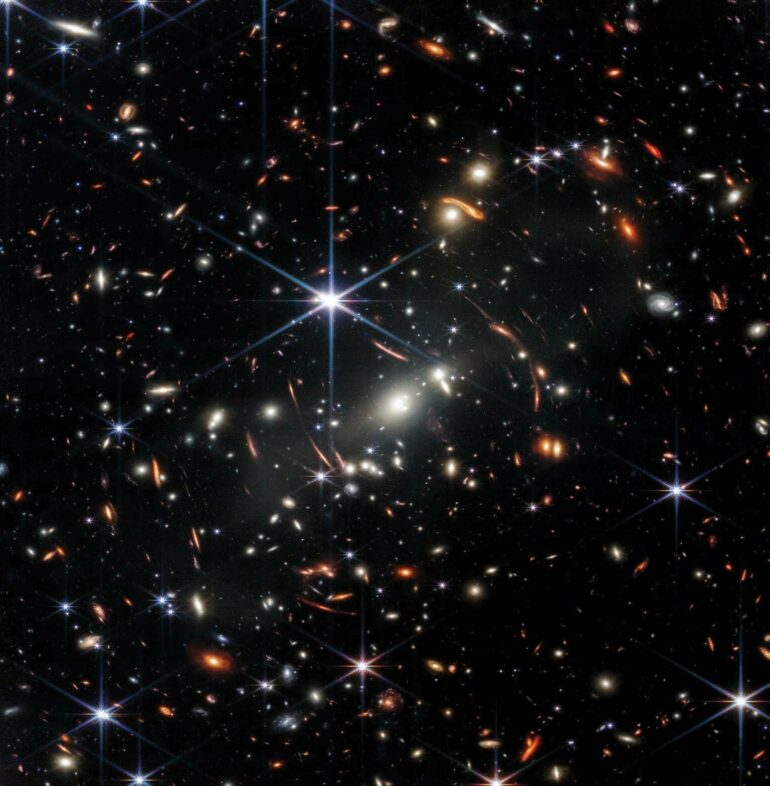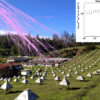Astrophysicists in Italy have shed new light on the nature of matter from the James Webb Space Telescope (JWST) detection of galaxies from 13 billion years ago and novel state-of-the-art numerical simulations of the first galaxies. The study adds another piece to the puzzle of the nature of matter in the universe.
While the commonly accepted paradigm of structure formation is based on non-relativistic matter that interacts only gravitationally, that is “cold” dark matter, alternative possibilities advocated to solve small-scale problems of the standard scenario rely on the hypothesis that dark matter is made of warm particles that possess a small, non-negligible, thermal velocity, namely “warm” dark matter.
“We found that the recent JWST galaxy detections in the first fraction of a billion years after the Big Bang are precious probes of the nature of matter,” says Dr. Umberto Maio, staff researcher at the Italian National Institute of Astrophysics (INAF), Astronomical Observatory of Trieste, and lead author of the paper describing the discovery just published in Astronomy & Astrophysics.
The research shows dark matter, the main constituent of matter in the universe, is made of particles that are either “cold” or just mildly “warm” with a mass larger than 2 keV. Dark-matter models with particle masses that are equal to or lighter than such limit are excluded by the study.
While previous works had ruled out the possibility to discriminate the nature of the matter by employing data at recent epochs, data at much earlier times and ad hoc numerical simulations—the basis of the new study—were needed to provide information about the statistical trends of primordial galaxies and break the degeneracies of the models.
“What we did was to apply our new, sophisticated, numerical implementation of early galaxy formation to interpret the latest JWST data,” Dr. Maio says. “We saw that, during the period when the first stars and galaxies form, the visible properties of the structures present in the universe depend on the dark-matter particle mass.”
Indeed, the study found evidence that the amount of cosmological star formation, ultraviolet luminosities and molecular abundances vary in different dark-matter models, and these variations can be contrasted with the latest JWST data, the first one reaching the “ancient” universe.
The research was a collaboration between the INAF-Astronomical Observatory of Trieste and the International School for Advanced Studies of Trieste, Italy. “The study was built on the exceptional observations of galaxies in the first half billion years detected with the JWST and early released in late 2022,” says Prof. Matteo Viel from the International School for Advanced Studies in Trieste and co-author of the research. “This is an important application of scientific data at such primordial epochs to constrain the nature of dark matter. Thanks to JWST we have observed the most distant galaxies in the universe and their properties give us clear information about their constituents.”
This major achievement was enabled by JWST, which is an international collaboration among the American National Aeronautics and Space Administration (NASA), the European Space Agency (ESA) and the Canadian Space Agency (CSA). The research shows how two observables, the galaxy luminosity function and the galaxy correlation function at small scales of faint objects, especially when used in combination, are promising tools for discriminating among different dark-matter models. The findings of the study are also in agreement with the properties of intergalactic medium, the “cosmic web,” at more recent epochs.
“In the future, when more data for small, dim, young sources will be available, further hints may come from early stellar-mass statistics and galaxy emission of carbon monoxide,” conclude the scientists. The discovery of such early galaxies demonstrate that these structures can form in only a fraction of billion years—which corresponds to the blink of an eye in cosmological contexts. Thus, more and more detections of primordial star-forming galaxies will be possible in the near future and this will pave the way for a better understanding of the nature of matter.
More information:
Umberto Maio et al, JWST high-redshift galaxy constraints on warm and cold dark matter models, Astronomy & Astrophysics (2023). DOI: 10.1051/0004-6361/202345851
Provided by
Astronomical Observatory of Trieste
Citation:
New evidence for the nature of matter from ancient galaxies in the early universe (2023, April 4)



